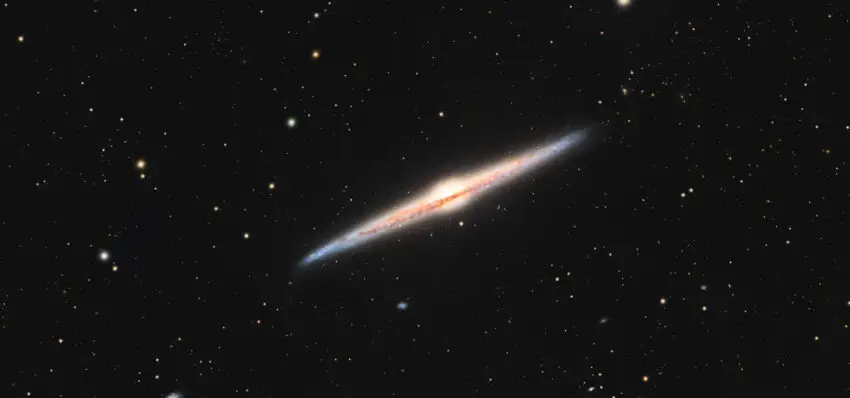This is my first return to an object I had photographed in the past. I’m revisiting it with a sense of nostalgia, deep curiosity, new experience, different equipment, and perhaps… a bit more patience. I remember that back then, the image was more of a test—taken to check the mount after maintenance and tuning—rather than a deliberate astrophotographic project.
NGC4665 – The Needle Galaxy
This photo session was preceded by maintenance and adjustments of my mount Losmandy G11. It came out really nice because the total error of the telescope guiding is within +/- 0.6 arc-sec . I am satisfied with such performance. The key for precise and smooth guiding are a well-lubricated and well-adjusted mount, sharp image of the guide scope and right selection of guidance parameters. NGC 4565 – The spiral galaxy commonly named “The Needle Galaxy”
The new image of NGC 4565 was captured at the turn of March and April this year from my remote setup at PixelSkiesAstro, located near Castilléjar in southern Spain. The observatory sits at an altitude of around 900 meters above sea level, in the Andalusian mountains, far from any light pollution (Bortle 2). At this time of year, NGC 4565 reaches an altitude of nearly 75° above the horizon at culmination, providing ideal conditions for capturing fine details and minimizing atmospheric distortion. NGC 4565 is one of the most well-known edge-on spiral galaxies. Its slender, needle-like silhouette earned it the English nickname ‘Needle Galaxy’. It was discovered in 1785 by William Herschel.
AstroBin: https://app.astrobin.com/i/jpzg7c
Galaxy Profile
NGC 4565 is one of the most well-known edge-on spiral galaxies. Its slender, needle-like silhouette earned it the English nickname “Needle Galaxy.” It was discovered in 1785 by William Herschel.
Morphological type: Sb (barred spiral galaxy)
Distance from Earth: ~40 million light-years
Diameter: ~100,000 light-years
Apparent magnitude: ~9.6 mag
Angular size: ~16′ × 2′
A distinctive feature of this galaxy is the dark dust lane cutting across its central bulge. This region is rich in cold gas and dust, where new stars are born. In a telescope, it appears like a shadow cast by a blade — in reality, it’s tens of billions of stars arranged in a thin spiral structure, invisible from our edge-on point of view.
Background Galaxies – Hidden Among the Stars
Although NGC 4565 naturally draws the eye, the long exposure time and dark skies also allowed me to capture a number of smaller, very distant background galaxies. To make them more visible, I’ve prepared a starless version of the image where these galaxies can be clearly seen. Among the visible galaxies are:
IC 4533 – an elliptical galaxy with a magnitude of ~14.4, located about 230 million light-years away, appearing as a faint, diffuse smudge.
NGC 3546 – a spiral galaxy with a magnitude of ~13.5, seen edge-on, resembling a miniature version of the Needle Galaxy.
NGC 3582 – a faint spiral galaxy with a magnitude of ~14.1, requiring long exposures to be properly captured.
NGC 3571 – a distant spiral galaxy with a magnitude of ~14.6, with subtle structure visible only in deep integrations.
NGC 4562 – a spiral galaxy with a magnitude of ~13.3, located close to NGC 4565 in the sky. Some catalogs list it as a potential member of a small galaxy group.
Each of these galaxies lies tens or even hundreds of millions of light-years farther away than NGC 4565 – which makes them all the more impressive when you consider that we are capturing their light after it has traveled through the cosmos for unimaginably long periods of time.
Technical card
Technical card
This image is more than just the result of technical effort — it’s a return to the place where it all began. A galaxy I once photographed in its most basic form now reveals so much more: its color, delicate dust lanes, extended halo, and distant background galaxies — the full complexity of the Universe in a single frame. Working on this photograph reminded me that even familiar objects can still surprise us — all it takes is time, patience, and the right tools. NGC 4565 continues to amaze me — perhaps now even more than it did before.
